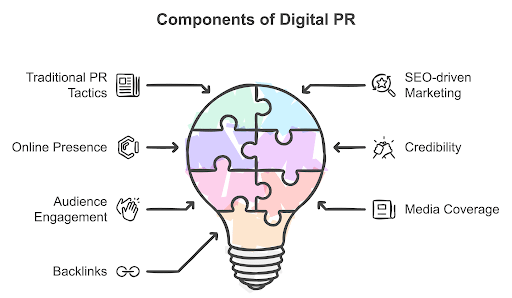What is Digital PR?

Higher education marketing departments face a daunting challenge: growing SEO performance while building brand awareness, all while being asked to do more with fewer resources. Traditional PR or SEO strategies alone often fall short, and this is where Digital PR steps in—a solution that bridges the gap between brand growth and search visibility. By integrating PR with SEO, Digital PR helps institutions create lasting connections and achieve measurable, data-driven outcomes.
What is Digital PR?
Digital PR merges traditional public relations tactics with advanced SEO strategies to boost a brand’s online presence, credibility, and audience engagement. Unlike conventional PR, which primarily targets print and broadcast media with key performance indicators (KPIs) such as impressions and brand recall, Digital PR not only incorporates these metrics but also emphasizes enhancing search engine results page (SERP) rankings, increasing domain authority, and driving website traffic and lead generation. This integrated approach enables Digital PR to deliver measurable outcomes that significantly improve both visibility and authority in the digital landscape.
Digital PR combines relationship-building with content creation to generate media coverage and earn high-quality backlinks. This can involve using experts, such as a professor in your program, to write articles or be featured in trending topics within publications or blogs. Once published, digital marketers reach out to reporters or webmasters to request backlinks to the website, which signals to Google that the site is credible due to the high domain authority of the publication. The more high-quality, relevant backlinks generated, the higher the site will rank for targeted keywords. This approach ultimately improves search engine rankings and enhances brand discoverability.
Why Digital PR Matters
Digital PR not only secures media coverage but also builds relationships that generate high-quality backlinks—crucial for boosting search engine rankings and brand visibility. By driving both SEO growth and brand awareness, Digital PR becomes an essential tool for modern marketing departments striving to make an impact. Digital PR helps brands improve their SEO by acquiring high-authority links, which boosts domain authority and organic rankings. For example, an amazing study from BuzzStream indicates a strong correlation between backlink quality and search engine rankings, emphasizing the importance of relevant and authoritative links. Unlike traditional PR, digital PR is a link-building strategy that helps drive organic traffic and brand visibility. Successful campaigns often combine unique content, such as surveys or proprietary data, to increase link intent, making content both SEO-optimized and highly pitchable.
For higher education institutions, Digital PR is especially powerful. Universities can leverage the expertise of their faculty to secure media coverage, positioning themselves as thought leaders in their fields. Unlike traditional PR, which is often limited to impressions, Digital PR provides measurable outcomes such as increased organic traffic and lead generation. This data-driven approach offers a clearer understanding of how PR efforts directly impact SEO and enrollment outcomes, making Digital PR an indispensable tool for growth.
Key Components of What Digital Digital PR Is
Content Creation and Distribution
Compelling content is the backbone of Digital PR. High-quality, shareable articles, infographics, and reports drive visibility by earning media placements and backlinks. Content that resonates with target audiences helps brands gain organic traction and establishes them as thought leaders.
Relationship Building
Building relationships with journalists, bloggers, and influencers is key to successful Digital PR. Effective outreach results in earned media mentions, which help increase brand credibility. Strong relationships ensure consistent coverage and exposure on reputable platforms, ultimately contributing to both brand authority and SEO success.
SEO Integration
Digital PR aims to secure valuable backlinks that improve search rankings. By integrating SEO with PR efforts, brands can boost their domain authority, making their websites more discoverable for targeted keywords. This results in increased organic traffic, ultimately driving brand growth.
Digital PR Tactics
Press Release Distribution
Press releases are a classic yet effective Digital PR tactic. In the digital era, press releases are optimized for SEO to ensure they contribute to brand visibility and attract online traffic. When distributing press releases, focus on creating a captivating headline, incorporating relevant keywords, and including links back to your site to enhance your SEO. Use digital distribution platforms to maximize reach and increase the chance of securing media coverage.
Media Pitching for Expert Commentary
Another highly effective tactic for Digital PR is media pitching for expert commentary. By keeping an eye on the news and understanding the expertise of your faculty, you can identify topics that matter to journalists and align with your institution’s strengths. This proactive approach allows you to pitch your faculty as subject matter experts who can provide valuable insights on trending topics. Journalists are always in need of fresh perspectives, and by offering new angles and positioning your professors within the news cycle, you create opportunities for earned media. This strategy leverages the wealth of knowledge available within your institution and is one of the most impactful ways to secure media coverage and build authority in the higher education space.
Influencer Outreach
Influencer outreach is about collaborating with individuals who have a significant online following to extend your brand’s reach. The key is to find influencers whose audience aligns with your target demographic. Effective influencer partnerships provide authentic exposure for your brand, making it more relatable. Whether it’s through blog posts, Instagram stories, or YouTube content, influencer endorsements can boost credibility and drive organic traffic.
Data-Driven Content
Data-driven content is a powerful way to build authority and attract media coverage. By conducting original research, surveys, or compiling data reports, brands can create newsworthy content that provides value to both journalists and readers. Data-driven content not only positions your brand as an industry thought leader but also encourages backlinks from reputable sources when they cite your findings, enhancing your SEO.
How to Pitch to Journalists and Stakeholders
Understanding Stakeholder Relevance
The key to a successful pitch is understanding what matters to the journalist and how your stakeholders fit into that narrative. Before reaching out, research the journalist’s beat—whether it’s technology, lifestyle, business, or any other field. Tailor your pitch to show how your brand’s story is relevant to current trends or their audience’s interests. If your stakeholders can add unique insights or expertise, this adds value to the journalist’s story, making it more appealing.
Crafting a Compelling Pitch
A pitch must be clear, concise, and demonstrate why the story matters. Start with a compelling subject line that grabs attention. In the body, briefly introduce who you are and why you’re reaching out. Address the problem your story solves, provide the unique angle, and explain why it’s timely. Avoid generic templates—personalize each pitch to show that you understand the journalist’s previous work and audience. Journalists receive numerous pitches daily, so ensure yours stands out by being direct and demonstrating real value.
Building Relationships with Journalists
Successful outreach goes beyond sending a one-time pitch. Building long-term relationships with journalists requires understanding their needs and consistently providing them with valuable content. This could involve offering exclusive data, industry insights, or expert commentary when relevant news breaks. Consistent follow-ups, respectful of journalists’ time, and genuine engagement help build a reliable rapport that can lead to recurring coverage and a stronger brand presence.
Measuring Digital PR Success
To effectively measure the success of a Digital PR campaign, it’s crucial to track key performance indicators (KPIs) that reflect both SEO improvements and audience engagement. Here are some of the key metrics to consider:
- Backlink Quality and Quantity: Backlinks are a core element of Digital PR. Measure the number of backlinks earned, but more importantly, assess the quality of these backlinks by considering factors like domain authority and relevance. High-quality backlinks from reputable websites will have a greater positive impact on SEO.
- Organic Traffic: Monitor changes in organic search traffic as Digital PR activities can lead to improved visibility in search engine results. Google Analytics is an essential tool to track how Digital PR efforts translate to increased visits from search engines.
- Social Media Engagement: Track social shares, comments, and likes on content that has been published as part of your Digital PR campaigns. Engagement metrics provide insight into how well your content resonates with audiences and can indicate increased brand awareness.
- Online Brand Mentions: Use tools like Mention or Brandwatch to monitor how frequently and where your brand is mentioned online. Positive brand mentions contribute to reputation building and increased brand authority.
- Referral Traffic: Measure referral traffic from the media coverage and influencer mentions you have gained. Referral traffic reflects the direct impact of Digital PR on driving visitors from third-party sites to your website.
- Sentiment Analysis: Beyond quantity, it’s important to understand the tone of your brand mentions. Sentiment analysis helps assess whether the coverage and discussions about your brand are positive, negative, or neutral, giving deeper insights into how Digital PR is affecting brand perception.
Tracking tools like Google Analytics, Ahrefs, SEMrush, and BuzzSumo are essential for monitoring these metrics and understanding the impact of your efforts on brand growth.
Conclusion
Digital PR is a powerful tool for enhancing brand visibility, boosting SEO, and establishing trust and credibility online. By combining traditional public relations principles with the reach and analytical capabilities of digital marketing, you can help your institution tell its story to a broader audience in ways that are both impactful and measurable.
For brands looking to increase their online presence, Digital PR offers a strategic and data-driven approach that yields tangible results. Whether through building relationships with key influencers, earning valuable backlinks, or crafting compelling stories, Digital PR is essential for modern brand growth.
If you’re ready to take your brand visibility and SEO to the next level, start implementing Digital PR strategies today and watch as your online presence strengthens and your audience expands.
Curious about how Digital PR can elevate your university’s reputation and boost SEO performance? Let’s chat about creating a strategic campaign that drives visibility and organic growth. Reach out to Campbell Learn today to start the conversation.

